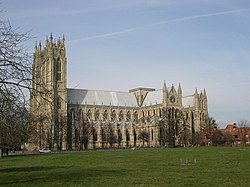
Bercthun of Beverley (died 15 May 733) also known as Bertin, Britwin, [1] Berhthu and Beorhthun, was an eighth century Anglo-Saxon saint. [2]
He was a Benedictine monk of Beverley, a disciple of John of Beverley and Bede's informant about much of Bede's history regarding Beverley. Latter in life he became the Abbot of Beverley. [3] He was also known from the secgan hagiographies.
A bust of Bercthun is thought to be kept in the British Library.
Be died on the 15 May 733, on which day his feast was locally kept. [4] A feast day was celebrated locally in his honour on the date of his death. [5]